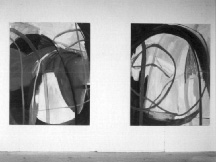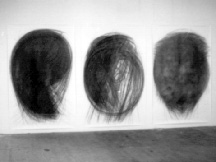- MAIN INDEX | ARTIST INDEX
| June 14 - 28, 1986 Thomas Hellinger and Doris Titze
| |
 Thomas Hellinger, installation view of untitled paintings, 1986. Photo Ali Kazimi. 18K |  Doris Titze, installation view of untitled drawings, 1986. Photo Ali Kazimi. 18K |
| PRESS RELEASE A studio exhibition sponsored by Mercer Union featuring work by two visiting German artists, Thomas Hellinger and Doris Titze, will open June 14 and continue to June 28. Having received a grant from the German Academic Exchange Service (DAAD) for the period of September 1985 to June 1986, Thomas Hellinger and Doris Titze chose to work and live in Toronto. This studio exhibition will be the complete and final presentation of the body of work these artists have developed during their stay in Toronto.
Thomas Hellinger will exhibit a series of tempera and oil paintings, and small mixed-media drawings. His work is primarily concerned with the experience of space.
Thomas Hellinger studied in Munich at the Akademie der bildenden Kuenste from 1977 to 1981 and the Hochschule der Kuenste in Berlin from 1981 to 1984, receiving his M.F.A. in 1984. Since 1980, he has participated in solo and group exhibitions in Munich and Berlin.
Doris Titze will exhibit drawings executed in graphite on paper. Her drawings are not definitions but rather associations in different senses, alluding to organic forms, (human) postures and segments of the body. These impressions bring forth an individualization of basic forms.
Doris Titze studied at the Akademie der bildenden Kuentse in Munich from 1978 to 1984, and received her M.F.A. in 1984. She received admission in the "Studienstiftung des dt. Volkes" in 1984, and a grant to Vienna in 1984/5. Doris Titze has exhibited in Edinburgh, London and Mulhouse, and has participated in numerous solo and group exhibitions in Germany.
THOMAS HELLINGER and DORIS TITZE Jane Perdue For two weeks this month, the public will be invited to view the most recent work of Thomas Hellinger and Doris Titze at their massive studio space in an old garment factory at the corner of Bathurst and Wellington. This studio exhibition, hosted by Mercer Union, provides a unique alternative to a formal gallery setting and an opportunity to speak with these two German artists who will be on hand to discuss their work. Both in their early 30s, Hellinger and Titze came to Toronto last September on a grant from the German Academic Exchange Service, a program set up in Germany, for graduate students. As Hellinger explains, "We wanted to come to North America and chose Toronto because we understood that it had a relatively new art scene. The city has been a good experience for us and we have found many interesting art activities here that continue to grow and develop." Hellinger and Titze both speak slowly and deliberately, choosing their words carefully. This is partly because of their hesitation with the English language but also because of their analytical approach to art. Says Hellinger, "What we do have in common is our approach and fundamental understanding that the process of making, the act of creating is very important. The work is, then, an approximation rather than a final statement. "We met at the same art institute in Munich and studied with-only one professor all year long--he too had this approach," adds Titze. While their attitudes are similar the artwork is very different. Hellinger's large tempera and oil paintings deal with the exploration of space and the "spatial structure of an image." The finished, untitled paintings are in constant motion, as the shapes and colours appear and disappear across the surface. Titze's strong graphic drawings on paper consist of hundreds of lines that extend as far as the radius of her arms and body will allow. Over and over, a certain gesture or rhythm is repeated, resulting in exceptional drawings that are organic and figurative in essence. "Even though I am always working with symmetry and the body in an abstract way," she says, "I always return to the basic forms such as the spiral, circle and triangle." After this studio show, the two head west to British Columbia to see the work of the Haida, which of particular interest to Titze. "I am intrigued by their work and always wanted to come to Canada for this reason." | |